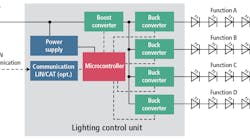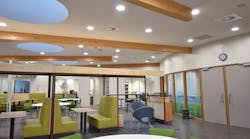Architectural and roadway lighting, along with a merged control interface, will make the new Tappan Zee Bridge under construction in New York an immediate icon.
Philips Lighting has announced that it will supply interconnected LED-based lighting, and controls technology for the new Tappan Zee Bridge that is currently under construction in New York's Hudson River Valley (seen in the nearby computer rendered illustration). Called the New NY Bridge project, the new Tappan Zee will have 419-ft towers lit by Philips Color Kinetics architectural LED lighting products and a road surface lit by RoadView solid-state lighting (SSL) luminaires.
The Tappan Zee Bridge, located north of Manhattan, is part of the New York State Thruway and connects South Nyack and Tarrytown across the Hudson River. The existing cantilever bridge will be replaced by an iconic suspended, cable-stayed structure that at 3.1 miles long is the largest bridge construction project in the New York State history. Towers will reach 419-ft heights. The center span will be finished in 2016, with the bridge opening planned for 2018.
Philips is working with the New York State Thruway Authority and Tappan Zee Constructors on the architectural LED lighting project. The striking new bridge will bring needed traffic relief along with state-of-the-art technology from construction techniques to lighting.
"We wanted to ensure that everything on this bridge would be the most advanced technology possible, which is why we partnered with Philips on the cloud-based lighting system for the Tappan Zee," said John Trinity, lead project engineer for the systems group at Tappan Zee Constructors. "Not only is the new lighting system energy-efficient, it will help the Tappan Zee stand out in the night sky and further cement it as an iconic New York structure, while the roadway lighting will be an integral part of improving visibility and making it safer for drivers. Moreover, the control system will eliminate the need to worry about maintaining server hardware or software systems, while still ensuring uptime because we can remotely log in to see if there are any issues, quickly and efficiently dispatching crews to address any concerns."
Much like the Bay Lights project on the Bay Bridge in San Francisco, the Tappan Zee will ultimately provide dynamic night-time shows to tens of thousands via the 2700 Philips Color Kinetics architectural LED lighting fixtures to be installed, although the Tappan Zee project will also include color-tunable fixtures. Philips will supply its Active Site control platform to both choreograph the lighting and for automated maintenance. Active Site has only recently become a Philips-branded product, but it is the same technology being used to control the dynamic lighting on New York's Madison Square Garden.
Meanwhile, the Philips CityTouch product will be used to control the more than 500 RoadView SSL luminaires that will deliver uniform, full-spectrum lighting on the road surface. The light levels will be managed for optimum energy efficiency while providing better visibility and safer passing for motorists.
In a twist, however, the CityTouch and Active Site control platforms will utilize a unified control interface. Both are cloud-based technologies, and Philips is merging the user interfaces into a single dashboard for the new Tappan Zee Bridge.
"Our understanding of architectural and roadway lighting, combined with our advanced controls technologies and our ability to develop a common user interface will allow Tappan Zee Constructors to deliver a cost-effective lighting system that can meet the demands of one the busiest bridges in New York," said Amy Huntington, president of Philips Lighting Americas. "As a company, we are delivering connected LED lighting systems that can be tailored to meet the exacting needs of our customers, and the New NY Bridge is a great example of a high-profile structure that needs the lighting system to be integrated in a very unique way."







